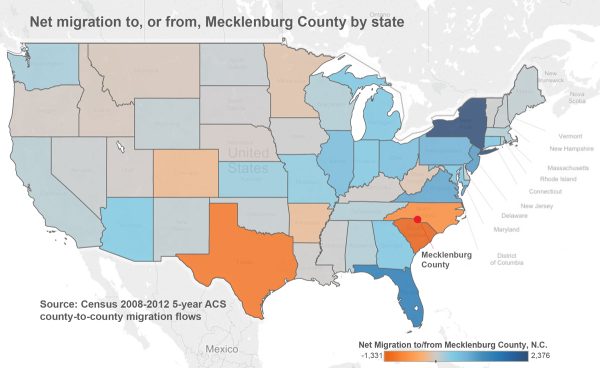Moving to Charlotte? You’re not alone

People move to Charlotte from all over the United States (and around the world). This trend has continued for several decades and shows no sign of slowing. What has been changing is where those people are moving from. And, believe it or not, Mecklenburg County loses more people to some locations than it gains.
Recently released data from the Census Bureau show that in 2013, Charlotte was the second-fastest growing large city in the nation, after Fort Worth, Texas. (Other N.C. cities with faster growth rates than Charlotte are Raleigh and Wilmington.) Several smaller towns around Charlotte have had growth rates higher than Charlotte’s in recent years. Much of that growth is occurring within Charlotte’s home county of Mecklenburg.
|
Data Dashboard Click here or scroll below to see interactive maps and graphs showing the county-to-county net flow of people to Mecklenburg County. |
The map above shows a snapshot of where people who move to Charlotte’s home county, Mecklenburg, are coming from. New York is king, sending an estimated more than 2,000 people to the county a year. Next is Florida, followed by New Jersey, Virginia and Pennsylvania. The Midwest in general is a net “sender” of people to Mecklenburg County.
On the other end of the scale is South Carolina. That state receives the largest number of residents on an annual basis from Mecklenburg County. Charlotte’s location on the S.C. border explains much of this – especially suburban York County, S.C., the largest net recipient of Mecklenburg residents in that state.
Texas, which is the next-highest on the receiving end of Mecklenburg residents, reflects a different kind of trend. The strength of the Texas economy, even through the recession, was a strong pull for migration.
The state next on Mecklenburg County’s list of net losses of people was North Carolina – other counties in the state. The N.C. county that received the highest net number of Mecklenburg residents is Union County, adjacent to southeast Charlotte and the Mecklenburg towns of Matthews and Mint Hill. Union County gained more than 1,600 residents from Mecklenburg in the survey data, the highest county-to-county flow nationally.
Another new trend is the net loss to West Virginia. That is another state that had a lower unemployment rate than the Charlotte area during much of the recession. Prior to the recession, it was common for migration from West Virginia to Charlotte to be much stronger.
The state summaries do not show the full story. A few counties within each state contribute the majority of net migrants (gains or losses) for Mecklenburg. For New York, the county that sent Mecklenburg the most residents is Suffolk, on Long Island. Tarrant County, Texas, home to Fort Worth, is the county in that state that receives the most Mecklenburgers.
The dashboard below allows for the exploration of these trends in detail, based on the 2008-2012 five-year census ACS (American Community Survey) county-to-county net migration flows.
